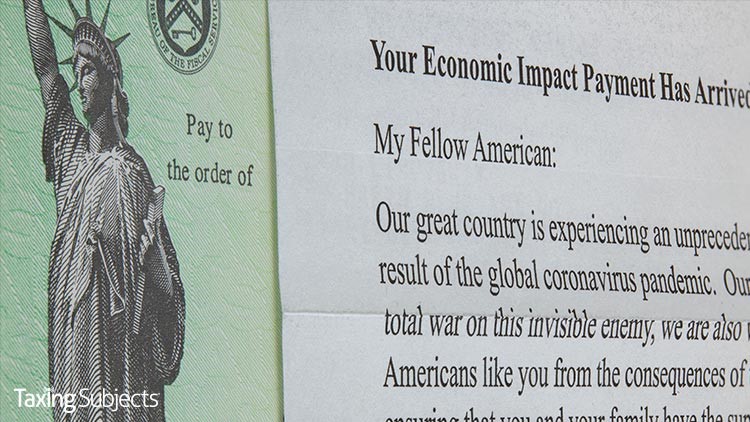
by | Sep 22, 2020 | Tax Tips and News
The IRS suggests electronic filing and payment options.
More than 150 million tax returns have been sent to the Internal Revenue Service, but many taxpayers still need to file for tax year 2019. That’s why the IRS recently reminded taxpayers that the extension deadline is less than a month away. (Those serving in combat zones or living in federally declared disaster areas may have more time to file.)
The deadline for taxpayers who requested an extension for their tax year 2019 individual income tax return have until October 15, 2020 to file with the IRS. As in years past, the agency recommends electronic filing and payment services. But in the pandemic landscape, convenience takes a back seat to safety.
“Taxpayers and tax professionals should continue to use electronic options to support social distancing and speed the processing of tax returns, refunds and payments,” the IRS says. Punctuating their recommendation, the IRS is temporarily allowing even more tax forms to be electronically signed.
What electronic payment options are available?
As for making payments, the IRS outlines a number of available electronic options, ranging from official applications to third-party payment processors. Here’s the full list—complete with explanations—from the press release:
- [Taxpayers] can pay when they file electronically using tax software online. If using a tax preparer, taxpayers should ask the preparer to make the tax payment through an electronic funds withdrawal from a bank account.
- IRS Direct Pay allows taxpayers to pay online directly from a checking or savings account for free, and to schedule payments up to 365 days in advance.
- Taxpayers can choose to pay with a credit card, debit card or digital wallet option through a payment processor. No fees go to the IRS.
- The IRS2Go app provides the mobile-friendly payment options, including Direct Pay and Payment Provider payments on mobile devices.
- Taxpayers may also enroll in the Electronic Federal Tax Payment System and have a choice of paying online or by phone by using the EFTPS Voice Response System.
- Taxpayers can go to IRS.gov/account to securely access information about their federal tax account. They can view the amount they owe, access their tax records online, review their payment history and view key tax return information for the most recent tax return as originally filed.
Those who are unable to pay their tax bill—whether in full or at all—also have options. The IRS has a number of online resources explaining installment payments, offers in compromise, and temporary collection delays under the “Can’t Pay Now?” heading of their “Payments” page.
Time is running out for non-filers to get an Economic Impact Payment in 2020.
Americans who don’t normally file a tax return need to send their information to the IRS in order to receive an EIP, and that deadline is also October 15, 2020. The IRSsays the easiest way for non-filers to, well, file, is by using the aptly named “Non-Filers: Enter Payment Info Here” tool on IRS.gov.
Source: IR-2020-213
– Story provided by TaxingSubjects.com

by | Sep 19, 2020 | Tax Tips and News
Many Oregon taxpayers are dealing with the damage caused by recent wildfires and severe storms. While victims have been forced to flee their homes beneath a smoky, orange sky, at least they have one less thing to worry about: The looming October 15 tax extension deadline.
The Internal Revenue Service yesterday announced, “Victims of the Oregon wildfires and straight-line winds that began on September 7 now have until January 15, 2021 to file various individual and business tax returns and make tax payments.” Here’s a list of some tax-related deadlines that are affected by the relief:
- September 15 quarterly estimated income tax payments
- October 15 individual income tax extensions
- October 15 calendar-year corporation extensions
- November 2 excise tax payments
- November 16 calendar-year tax-exempt extensions
The IRS also says that “penalties on payroll and excise tax deposits due on or after September 7 and before September 22 will be abated as long as the deposits are made by September 22, 2020.” Keep in mind that this tax relief does not apply to the July 15 tax payment deadline.
Who qualifies for tax relief due to Oregon wildfires and straight-line winds?
You can qualify for the new tax extension deadline if the Federal Emergency Management Agency has officially declared where you live to be a “disaster area.” Currently, the following counties have been identified for tax relief:
- Clackamas
- Douglas
- Jackson
- Klamath
- Lane
- Lincoln
- Linn
- Marion
Be sure to bookmark “Tax Relief in Disaster Situations” on the IRS website for the most up-to-date list of affected areas. As with other natural disasters, the areas eligible for relief may grow depending on the path taken by the fire and storms. Even if no further damage is caused, FEMA can still continue to identify areas for relief as they continue surveying the situation.
What do I have to do to qualify for wildfire tax relief in Oregon?
If the address on record with the IRS falls inside a disaster area, you don’t have to do anything to benefit from the new deadlines. That isn’t to say that people won’t receive late-filing notices from the IRS. In that case, the IRS says “the taxpayer should call the number on the notice to have the penalty abated.”
Relief workers, charities, and taxpayers who have business dealings inside the disaster area may also qualify for tax relief. These individuals and organizations will need to call 866.562.5227 to speak with IRS representatives to receive tax relief.
Is tax relief available for other disaster areas?
Since hurricanes, tornadoes, and earthquakes seem to be a permanent fixture in national headlines, it’s important to remember that this tax relief generally becomes available whenever any large-scale natural disaster strikes. If you are the victim of a recent natural disaster, visit the IRS disaster relief page to see if your area has received tax relief.
Source: IR-2020-215
– Story provided by TaxingSubjects.com

by | Sep 19, 2020 | Tax Tips and News
Some nine million letters are being sent later this month in a special mailing to people who haven’t had a need to file a tax return but may qualify for a Economic Impact Payment (EIP). The letters will encourage them to see if they’re eligible for an EIP.
The notices also let the recipients know there’s an Oct. 15 deadline to register for an EIP, and they can use the special Non-Filers: Enter Payment Info Here tool on IRS.gov to do it.
“The IRS continues to work hard to reach people eligible for these payments,” said IRS Commissioner Chuck Rettig. “These mailings are the latest step by the IRS to reach as many people as possible for these important payments. We are releasing this state-by-state information so that state and local leaders and organizations can better understand the size of this population in their communities and assist them in claiming these important payments. Time is running out to claim a payment before the deadline.”
The letters are part of a final stage of the IRS’s outreach and public awareness campaign on the Economic Impact Payments that started in March. The effort included IRS reaching out to thousands of partner groups across the country—including partner groups working with underserved communities, people experiencing homelessness, and those whose primary language isn’t English.
So far, the IRS says some seven million people have already used the Non Filers Tool to register for a payment.
The September letters will be sent from an IRS address and will be sent to people who haven’t filed a return for either 2018 or 2019. IRS research shows these are people who don’t typically have a tax return filing requirement because they appear to have very low incomes based on Forms W-2 and 1099, and other third-party statements available to the IRS.
The IRS cautions that receiving a letter is not a guarantee of eligibility. An individual is likely eligible for an Economic Impact Payment if they:
- are a U.S. citizen or resident alien;
- have a work-eligible Social Security number; and
- can’t be claimed as a dependent on someone else’s federal income tax return.
For more information on eligibility requirements, see the Economic Impact Payment eligibility FAQs on IRS.gov.
The IRS has released a state-by-state breakdown of the non-filer letters to be mailed. California leads the pack with 1.18 million letters to be received by the state’s citizens. Wyoming and Vermont hold down the smallest part of the spectrum, with 14,000 and 13,000 recipients respectively.
Who needs to file?
The IRS emphasizes that anyone required to file either a 2018 or 2019 tax return should file the tax return and not use the Non-Filers Tool. The online tool is designed for people with incomes typically below $24,400 for married couples, and $12,200 for singles. This includes couples and individuals who are homeless.
Those unable to access the Non-Filers Tool may submit a simplified paper return following the steps described in the Economic Impact Payment FAQs on IRS.gov.
Anyone using the Non-Filers Tool can speed up the arrival of their payment by choosing to receive it by direct deposit. Those not choosing this option will get a check.
Beginning two weeks after they register, people can track the status of their payment using the Get My Payment tool, available only on IRS.gov.
– Story provided by TaxingSubjects.com

by | Sep 17, 2020 | Tax Tips and News
The Internal Revenue Service says it’s continuing to look for ways to assist taxpayers taxpayers who’ve been affected by the COVID-19 pandemic. To that end, the agency is reminding taxpayers and tax professionals alike there are special procedures in place to speed up requests for letter rulings under Rev. Proc. 2020-1, 2020-1 I.R.B. 1 (January 2, 2020).
As Rev. Proc. 2020-1 sets out, the IRS ordinarily processes requests for letter rulings in the order they’re received. A taxpayer who has a compelling need to have a request processed more quickly can request expedited handling.
A request for expedited handling must be made in writing — preferably in a separate letter submitted with the letter ruling request. Applications for expedited handling are granted at the discretion of the IRS and typically involve factors outside the taxpayer’s control that create a real need to obtain a letter ruling before a certain date to avoid serious business consequences.
Expedited-handling requests should be submitted as promptly as possible after the taxpayer becomes aware of the deadline or compelling need.
Does the coronavirus qualify as a factor outside a taxpayer’s control?
The COVID-19 pandemic is one of the factors outside a taxpayer’s control that can support a request for expedited handling under Rev. Proc. 2020-1.
As a result, taxpayers are encouraged to seek expedited handling if they face a compelling need related to COVID-19. This is consistent with Executive Order 13924 of May 9, 2020.
Information on procedures for requesting expedited handling is provided in Section 7.02(4) of Rev. Proc. 2020-1.
Rev. Proc. 2020-29, 2020-21 I.R.B. 859 (May 18, 2020), also sets out procedures for electronic submission of letter-ruling requests.
– Story provided by TaxingSubjects.com

by | Sep 15, 2020 | Tax Tips and News
The Internal Revenue Service has followed through on its promise to add digital signature capability to more tax forms, enabling an additional six forms to use the feature.
On Aug. 28, the agency announced it would temporarily allow the use of digital signatures on certain forms that can’t be e-filed. Now, more forms have been added to that list.
The change in e-signature policy is driven by the pandemic.
The decision was made in order to protect the health of taxpayers and tax professionals alike during the COVID-19 pandemic. The change helps to ensure that in-person contact and the resulting risks to taxpayers and preparers can be reduced, while allowing both to work remotely and file forms in a timely manner.
These forms have been added to the list of those being accepted digitally:
- Form 706, U.S. Estate (and Generation-Skipping Transfer) Tax Return;
- Form 706-NA, U.S. Estate (and Generation-Skipping Transfer) Tax Return;
- Form 709, U.S. Gift (and Generation-Skipping Transfer) Tax Return;
- Form 1120-ND, Return for Nuclear Decommissioning Funds and Certain Related Persons;
- Form 3520, Annual Return To Report Transactions With Foreign Trusts and Receipt of Certain Foreign Gifts; and
- Form 3520-A, Annual Information Return of Foreign Trust With a U.S. Owner.
These forms are available on the IRS website and through tax professional software. These forms cannot be e-filed. Generally, they are printed and mailed.
Which tax forms did the IRS initially allow e-signatures for on August 28, 2020?
The new forms join the original list that was announced Aug.28. All these forms can be submitted with digital signatures if they are mailed by or on Dec. 31, 2020:
- Form 3115, Application for Change in Accounting Method;
- Form 8832, Entity Classification Election;
- Form 8802, Application for U.S. Residency Certification;
- Form 1066, U.S. Income Tax Return for Real Estate Mortgage Investment Conduit;
- Form 1120-RIC, U.S. Income Tax Return For Regulated Investment Companies;
- Form 1120-C, U.S. Income Tax Return for Cooperative Associations;
- Form 1120-REIT, U.S. Income Tax Return for Real Estate Investment Trusts;
- Form 1120-L, U.S. Life Insurance Company Income Tax Return;
- Form 1120-PC, U.S. Property and Casualty Insurance Company Income Tax Return; and
- Form 8453 series, Form 8878 series, and Form 8879 series regarding IRS e-file Signature Authorization Forms.
The IRS continues to monitor the temporary option for e-signatures and will determine if further steps are needed.
An IRS release says the agency understands the importance of digital signatures to the tax community.
“The agency will continue to review its processes to determine where long-term actions can help reduce burden for the tax community, while at the same appropriately balancing that with critical security and protection against identity theft and fraud,” the IRS writes.
– Story provided by TaxingSubjects.com






